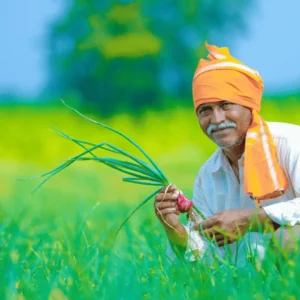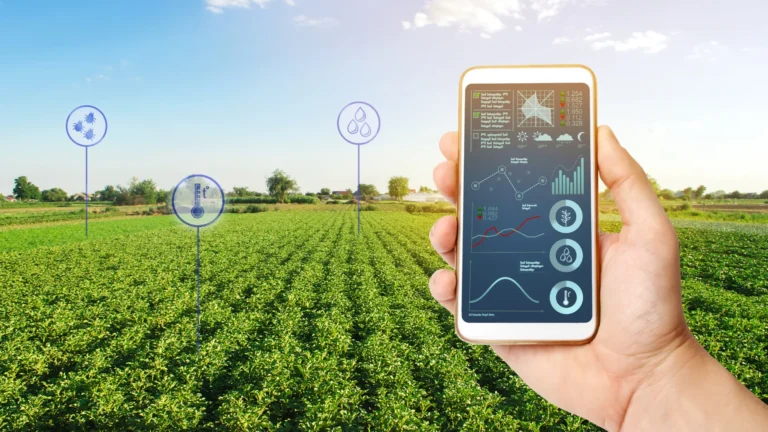- Made In INDIA

The Indian agricultural sector stands at the cusp of a revolutionary transformation, poised to harness the power of digital technologies and propel the nation towards a more sustainable and prosperous future. As the world’s population continues to grow, the need for efficient and resilient food production systems has become more pressing than ever before. India, with its rich agricultural heritage and vast potential, is uniquely positioned to lead this digital revolution and shape the future of farming.
The term “digital transformation” has become a buzzword across various industries, but what does it truly entail for the Indian agricultural sector? At its core, digital transformation in agriculture involves the integration of cutting-edge technologies into every aspect of farming operations, from soil preparation and crop cultivation to harvesting, storage, and distribution. This transformation is not merely a technological shift but a paradigm shift in how we approach agriculture, leveraging data-driven insights, precision farming techniques, and innovative business models.
The driving forces behind this transformation are multifaceted, ranging from the pressing need to feed a rapidly growing population to the imperative of addressing the challenges posed by climate change and resource scarcity. Additionally, changing consumer preferences and the demand for transparency and sustainability in food production, alongside advancements like hardware-in-virtual-reality, have further accelerated the adoption of digital solutions in Indian agriculture.
The digital revolution in Indian agriculture is a multifaceted endeavor, encompassing a diverse array of technologies that are collectively redefining the industry’s landscape. Among these transformative technologies are:
Precision agriculture, powered by the Internet of Things (IoT), is at the forefront of the digital transformation in Indian agriculture. This approach involves the use of advanced sensors, GPS technology, and remote sensing to monitor soil conditions, weather patterns, crop growth, and livestock health in real-time. By collecting and analyzing this wealth of data, farmers can make informed decisions about when and where to apply inputs such as water, fertilizers, and pesticides, optimizing resource utilization and minimizing waste.
IoT-enabled smart farming systems are rapidly gaining traction in India, with farmers embracing connected devices and sensors that provide valuable insights into their fields and crops. These systems not only enhance efficiency but also promote sustainability by reducing the environmental impact of agricultural practices.
The introduction of robotics and automation technologies is revolutionizing the way farming operations are conducted in India. From autonomous tractors and drones for precision seeding and crop monitoring to robotic harvesters and sorting machines, these technologies are increasing productivity, reducing labor requirements, and enhancing safety and precision in agricultural tasks.
Drones, in particular, have emerged as a game-changer in Indian agriculture. These unmanned aerial vehicles (UAVs) can capture high-resolution images and data from fields, providing valuable information about crop health, soil conditions, and potential pest or disease infestations. By leveraging this data, farmers can make timely interventions and optimize their crop management strategies.
The digital transformation in Indian agriculture is generating vast amounts of data from various sources, including IoT sensors, weather stations, and satellite imagery. To make sense of this deluge of data and extract valuable insights, the power of artificial intelligence (AI) and big data analytics is being harnessed.
AI algorithms and machine learning models are being applied to analyze this data, enabling predictive analytics and decision support systems. These technologies can forecast crop yields, identify potential risks, and recommend optimal farming practices based on historical data and real-time conditions. Additionally, AI-powered image recognition technologies can detect plant diseases and pests with remarkable accuracy, allowing for early intervention and minimizing crop losses.
Ensuring transparency and traceability throughout the agricultural supply chain is a crucial aspect of the digital transformation in Indian agriculture. Blockchain technology, with its decentralized and immutable ledger, is being leveraged to track the journey of agricultural products from farm to fork.
By integrating blockchain with radio-frequency identification (RFID) tags and IoT sensors, stakeholders in the supply chain can access real-time data about the provenance, quality, and handling of agricultural products. This not only enhances food safety and quality but also enables consumers to make informed choices based on the sustainability and ethical practices involved in the production process.
The advent of digital marketplaces and e-commerce platforms has disrupted traditional agricultural marketing channels, empowering Indian farmers to connect directly with buyers and consumers. These platforms provide farmers with access to a broader market, enabling them to sell their produce at fair prices while reducing the involvement of intermediaries.
Online platforms like eNAM (National Agriculture Market), AgriBazaar, and Krishify are revolutionizing the way agricultural commodities are traded in India. Farmers can list their products, negotiate prices, and even facilitate logistics through these digital channels, streamlining the supply chain and increasing their profit margins.
The availability of high-resolution satellite imagery and remote sensing technologies has opened up new avenues for precision agriculture in India. By analyzing these images, farmers and agronomists can assess crop health, identify areas of stress or disease, and monitor soil moisture levels across vast areas.
Additionally, satellite data can be used to create detailed maps of crop yields, soil characteristics, and other variables, enabling farmers to make informed decisions about crop rotation, irrigation, and input application. This data-driven approach to farming not only enhances productivity but also promotes sustainable resource management.


Computers are at the heart of the digital transformation in Indian agriculture, serving as the backbone for the implementation and operation of various technologies. From data collection and analysis to automation and decision support, computers play a crucial role in enabling the seamless integration of digital solutions into farming practices.
The vast amounts of data generated by sensors, drones, satellites, and other digital devices in agriculture require powerful computing capabilities for processing, storage, and analysis. High-performance computers and cloud computing platforms are essential for handling big data sets, running complex algorithms, and extracting valuable insights that inform decision-making processes.
The application of artificial intelligence (AI) and machine learning in agriculture relies heavily on robust computing power. Computers are responsible for training AI models using large datasets, enabling them to recognize patterns, make predictions, and provide recommendations for optimizing farming operations. From crop yield forecasting to disease detection and soil analysis, AI-powered solutions are transforming agriculture, and computers are the driving force behind these advancements.
Computers are the brains behind the automation and robotics technologies that are revolutionizing farming practices. Autonomous tractors, robotic harvesters, and precision planting systems are controlled by computers that process real-time data, navigate complex environments, and execute tasks with utmost accuracy and efficiency.
The Internet of Things (IoT) in agriculture involves a network of connected devices and sensors that continuously collect and transmit data. Computers play a vital role in receiving, processing, and analyzing this data, enabling precision agriculture practices such as site-specific input application, real-time monitoring, and automated irrigation systems.
Computers are essential for enabling supply chain traceability and the operation of digital marketplaces in agriculture. Blockchain technology, which underpins many traceability systems, relies on computers to securely record and verify transactions. Additionally, e-commerce platforms and online marketplaces are powered by computers, facilitating the seamless buying and selling of agricultural products.
Computers are invaluable tools for simulating and modeling various agricultural scenarios, with capabilities extending to areas like maximising battery life. Through computational models, researchers and farmers can simulate crop growth under different environmental conditions, test the efficacy of new farming practices, and optimize resource allocation before implementing changes in the field.
Farm management software and decision support systems are computer-based applications that assist farmers in making informed decisions. These systems integrate data from multiple sources, including weather forecasts, market trends, and historical records, to provide recommendations on planting schedules, input applications, and harvesting times.
As the digital transformation in Indian agriculture continues to gain momentum, the role of computers will become even more critical. The development of more powerful and energy-efficient computing technologies, coupled with advancements in areas like quantum computing and edge computing, will further enhance the capabilities of digital solutions in agriculture. By leveraging the power of computers, Indian farmers can unlock new levels of efficiency, productivity, and sustainability in their operations, positioning the nation as a global leader in the digital agriculture revolution.


To effectively implement and support the various digital transformation technologies in Indian agriculture, computers with specific hardware specifications are required. These specifications ensure that the computers have the necessary processing power, storage capacity, and other capabilities to handle the demanding workloads and data-intensive tasks involved. Here are some of the key specifications required:
High-performance multi-core processors with advanced architectures, such as Intel Core i5 or Intel Core i7 or AMD Ryzen 5, 7 series or better
Processors designed for server or workstation applications, like Intel Xeon or AMD EPYC series, are recommended for large-scale deployments or high-compute tasks like AI/ML model training
8GB to 32GB RAM or more is recommended for data-intensive applications like precision agriculture, image processing, and AI/ML workloads
Support for Error Correcting Code (ECC) memory for enhanced data integrity and reliability
Solid-state drives (SSDs) for faster data access and improved performance compared to traditional hard disk drives (HDDs)
Large-capacity HDDs or network-attached storage (NAS) solutions for storing and archiving large volumes of agricultural data
High-performance GPUs from NVIDIA (e.g., GeForce RTX or Quadro series) or AMD (e.g., Radeon Pro series) for accelerating AI/ML workloads, image processing, and computationally intensive tasks. Multiple GPUs or GPU clusters may be required for advanced AI/ML applications
Gigabit Ethernet or faster network interfaces for efficient data transfer and communication. Support for Wi-Fi 6 (802.11ax) or 5G connectivity for reliable wireless connectivity in remote farm locations
USB 3.0 or Thunderbolt ports for connecting various devices, such as sensors, cameras, and peripherals. HDMI or DisplayPort for connecting multiple displays or projectors for data visualization
Windows 10 Professional or Enterprise editions for compatibility with various agricultural software and applications. Linux distributions like Ubuntu or CentOS for server applications, high-performance computing (HPC), and cloud deployments
High-efficiency power supply units (PSUs) with sufficient wattage to support the system’s components. Adequate cooling solutions, such as liquid cooling or advanced air cooling systems, for high-performance workloads
Ruggedized laptops or tablets with robust enclosures, water and dust resistance, and shock protection for use in harsh farm environments. Fanless or passive cooling designs for reliable operation in extreme temperatures
It’s important to note that these specifications are general guidelines, and the actual requirements may vary depending on the specific digital transformation technologies being implemented, the scale of the deployment, and the workload demands. Additionally, as new technologies emerge and data volumes grow, the hardware specifications may need to be updated or scaled up accordingly.
The digital transformation in Indian agriculture is not just about adopting new technologies; it is also fostering the emergence of innovative business models that are reshaping the industry’s landscape. These models include:
To overcome the financial barriers that often impede the adoption of advanced technologies, companies are offering Precision Agriculture as a Service (PAaS).
Under this model, farmers can access cutting-edge precision agriculture technologies, such as drones, sensors, and data analytics platforms, without the need for significant upfront capital investment. Instead, they pay a subscription fee or a usage-based charge, making these technologies accessible to even smallholder farmers.
Digital platforms are enabling Indian farmers to bypass traditional intermediaries and establish direct connections with consumers. By leveraging e-commerce platforms and social media, farmers can market and sell their produce directly to end-users, capturing a larger share of the profit and aligning with consumer preferences for sustainably sourced and traceable food.
These direct-to-consumer channels not only increase farmers’ incomes but also foster transparency and trust between producers and consumers, promoting a more equitable and sustainable food system.
The wealth of data generated by digital technologies in agriculture has given rise to a new breed of businesses that offer data-driven insights and advisory services to farmers. These companies leverage AI algorithms and machine learning models to analyze data from various sources, including weather patterns, soil conditions, and market trends, and provide tailored recommendations to farmers.
By subscribing to these services, farmers can optimize their operations, increase yields, and make informed decisions based on data-driven insights, reducing the risks associated with traditional farming practices.
The digital transformation in Indian agriculture has paved the way for the emergence of urban and vertical farming initiatives. These innovative farming approaches leverage advanced technologies, such as hydroponics, aeroponics, and controlled environment agriculture, to grow crops in urban settings, reducing transportation costs and carbon emissions associated with traditional farming.
By bringing food production closer to urban centers, these initiatives not only address food security concerns but also contribute to the development of sustainable and resilient cities. Additionally, urban and vertical farming provide opportunities for entrepreneurship and job creation in the agricultural sector.


While the digital transformation in Indian agriculture holds immense promise, several challenges must be addressed to ensure its successful implementation and long-term sustainability:
The cost of adopting digital technologies can be prohibitive for many smallholder farmers in India, who constitute a significant portion of the agricultural workforce. To bridge this digital divide, collaborative efforts between the government, private sector, and financial institutions are necessary to provide subsidies, grants, and innovative financing models that make these technologies accessible and affordable.
As the volume of agricultural data continues to grow, robust cybersecurity measures and data privacy protocols must be implemented to protect sensitive information from potential breaches and misuse. This requires the development of secure data management systems, encryption technologies, and robust governance frameworks to ensure the responsible use of data.
The successful adoption of digital technologies in Indian agriculture hinges on the availability of a skilled workforce. Farmers, extension workers, and agricultural professionals must receive comprehensive training and education programs to develop the necessary digital literacy and technical skills required to effectively utilize these technologies.
Reliable and widespread internet connectivity, along with robust digital infrastructure, is a prerequisite for the widespread adoption of digital technologies in Indian agriculture. This necessitates investments in improving rural broadband networks, establishing data centers, and developing robust cloud computing platforms to support the seamless flow and processing of agricultural data.
A clear and supportive regulatory framework is crucial for fostering innovation and responsible adoption of digital technologies in Indian agriculture. Policymakers must work closely with stakeholders to develop guidelines and standards that address issues such as data ownership, privacy, and security, while also promoting the ethical use of emerging technologies like AI and blockchain.
Additionally, policies should incentivize and facilitate public-private partnerships, encouraging collaboration between technology companies, agribusinesses, and research institutions to drive innovation and accelerate the digital transformation in Indian agriculture.
While digital technologies offer immense opportunities for increasing productivity and efficiency in Indian agriculture, their environmental impact must be carefully considered. The development and deployment of these technologies should prioritize sustainability, minimizing their carbon footprint, and promoting the responsible use of natural resources.
Initiatives such as the use of renewable energy sources to power digital infrastructure, the implementation of circular economy principles in the design and production of agricultural technologies, and the promotion of regenerative farming practices should be integrated into the digital transformation process.
The digital transformation in Indian agriculture is not merely a technological shift; it represents a paradigm shift in how we approach food production, distribution, and consumption. By embracing these transformative technologies and innovative business models, India has the potential to become a global leader in sustainable and resilient agriculture.
Collaboration and partnerships will be key to unlocking the full potential of this transformation. Public-private partnerships, involving government agencies, technology companies, research institutions, and farmer cooperatives, can accelerate the development and adoption of digital solutions tailored to the unique needs of Indian agriculture.
Furthermore, fostering a culture of innovation and entrepreneurship within the agricultural sector will be crucial. By encouraging startups and agritech companies to develop cutting-edge solutions, India can drive local innovation and create a thriving ecosystem that supports the digital transformation.
Education and capacity building are also critical components of this journey. Investing in agricultural education programs that incorporate digital literacy and technical skills will equip the next generation of farmers with the knowledge and expertise required to navigate the digital age.
Lastly, the digital transformation in Indian agriculture must be inclusive and equitable, ensuring that the benefits of these technologies reach smallholder farmers and marginalized communities. By addressing the digital divide and providing targeted support, India can leverage the power of digital technologies to uplift rural economies and promote sustainable development.
As we move forward, the digital transformation in Indian agriculture will continue to evolve, presenting new opportunities and challenges. However, by embracing innovation, fostering collaboration, and prioritizing sustainability, India can pave the way for a more resilient, productive, and equitable food system, ensuring food security for its growing population while preserving the planet for future generations.
©2024 Holoware® Computers Pvt. Ltd. | Privacy Policy | Terms & Condition
Roles & Responsibilities:
Preferred candidate profile:
Key Skills:
Location: Guindy & Porur
No of Openings: 3
Hindi Speaking is preferred
Fresher to 4 years experience in the relevant field is preferred.
Job description
We are seeking a motivated and detail-oriented Sales Coordinator to join our dynamic sales team. The Sales Coordinator will play a key role in supporting our sales representatives and ensuring smooth operations within the sales department. This position offers an exciting opportunity to contribute to the success of our sales initiatives and provide excellent customer service to our clients.
Role & responsibilities
Preferred candidate profile
Perks and benefits
Warranty Offers
Services with those steps are available
Solution With 24/7 Support
Get Started


In 1994, Mr.Thangavel started Origin Information Technology (in partnership with Mr. Loganathan) to provide quality computer hardware sales and service. In the year 2022, the company name was changed to “Tinkas Industries Private Limited” to encompass its diversified activities. Mr. Thangavel feels that he can give back to his nation the growth it needs in many ways like providing employment opportunities to many, and doing CSR activities, etc. His goal is to make Tinkas a leader at the National and Internaltional levels.
Holoware CEO abut Tinkas CEO
“The CEO of Tinkas (Mr.Thangavel) is undeniably one of the most practical and resourceful individuals I’ve encountered in Tamil Nadu. His profound understanding of the industry coupled with his diverse business ventures truly exemplifies his wealth of knowledge. Partnering with Tinkas has been a delight, and we eagerly anticipate further growth and collaboration.”
Mr. Ketan Patel is an indomitable entrepreneur revolutionizing the landscape of electronic consumer products worldwide through an unparalleled ‘experiential journey.’ Leading Creative Newtech since 1992, he steered its growth from a Mumbai market trader to a distributor and Brand Licensee. As an alumnus of IIM-Bangalore, Mr Patel leads Creative Newtech with a focus on innovation and strategic leadership. Under his three-decade leadership, Creative Newtech has become India’s market leader, expanding globally across Hong Kong, the Middle East, and the SAARC region.”
Holoware CEO abut Creative Newtech CEO
“The CEO of Creative (Mr.Ketan Patel) is a highly knowledgeable leader, renowned for his expertise in distributorship. His intuitive knack for product selection and sales strategies, both in India and abroad, is impressive. Creative thrives as a powerhouse, fueled by its diverse team and collective expertise. We eagerly look forward to a promising future and further success in our collaboration with Creative.”


Inmac Computers Private Limited is a trailblazing name in the realm of IT services and solutions. With a remarkable inception in 1992 by visionary entrepreneurs Girish Babu and Asha Girish Babu, our company has consistently remained at the forefront of technological innovation, setting new standards for excellence in the industry.
Holoware CEO abut Inmac CEO
“Inmac’s CEO (Mr.Girish Babu) is one of the most humble and generous individuals I’ve ever had the pleasure of meeting. His leadership has been instrumental in steering his team to success, not just in Maharashtra but across various regions in India. Their financial stability over the years speaks volumes about his capabilities. It’s truly a delight to collaborate with someone of his caliber. I look forward to continued partnership with Inmac.”